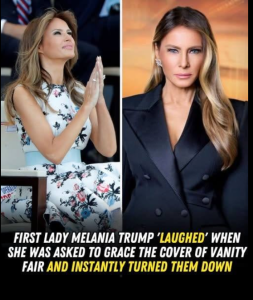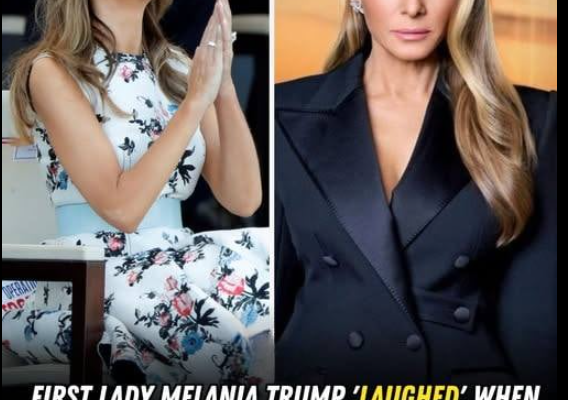“The Laugh Heard Around the Glossy World”
It began with a whisper in the halls of Condé Nast. A new editor at Vanity Fair, Mark Guiducci, freshly installed and eager to redefine the magazine’s relationship with power, floated a provocative idea: Melania Trump on the cover. Not just a fashion spread, but a feature—a statement. A reckoning.
The reaction was volcanic.
Inside the editorial offices, mid-level staffers reportedly threatened to walk out. “If Guiducci puts Melania on the cover, half my staff will walk out, I guarantee it,” one editor fumed. Another declared they’d rather bag groceries at Trader Joe’s than contribute to what they saw as a normalization of despotism.
But the storm outside the Trump orbit was met with a breeze inside it. Melania Trump, when approached with the offer, reportedly laughed. Not a bitter scoff, not a political rebuttal—just a laugh. And then she declined.
That laugh became the pivot point of the entire narrative. It wasn’t just a rejection of a magazine cover. It was a rejection of the cultural machinery that had long excluded her, vilified her, and now—perhaps too late—wanted her back.
Melania Trump has always been a paradox. A former model fluent in five languages, she entered the White House as one of the most visually poised First Ladies in history. Yet she remained elusive, distant, almost spectral. Her “Be Best” campaign was mocked. Her fashion choices were dissected. Her silence was interpreted as complicity, mystery, or quiet rebellion—depending on who was looking.
Unlike Michelle Obama, Hillary Clinton, or even Jill Biden, Melania was conspicuously absent from the pages of Vogue and Vanity Fair during her husband’s presidency. Her only Vogue cover came in 2005, featuring her wedding to Donald Trump. Since then, the fashion world had largely turned its back on her, citing political and moral objections.
So when Vanity Fair came knocking in July 2025, it wasn’t just an editorial decision—it was a cultural gamble. Could the magazine reconcile its liberal readership with a glossy celebration of a woman married to one of the most polarizing figures in modern history?
Melania’s response—her laugh—was more than a dismissal. It was a mirror held up to the industry that had once courted her, then shunned her, and now sought to reclaim her. “She doesn’t have time to be sitting in a photo shoot,” a source close to her reportedly said. “Her priorities as First Lady are far more important… These people don’t deserve her anyway”.
The phrase “don’t deserve her” echoed like a challenge. It suggested not just rejection, but judgment. Melania, often portrayed as passive or ornamental, had made a decision rooted in agency. She wasn’t interested in redemption through fashion. She wasn’t seeking validation from the same institutions that had denied her.
And then came the spoof.
An AI-generated image of Melania wearing a crown, dubbed “The American Queen,” began circulating online. The cover teased a story about her “Silent Revolution,” with the tagline: “Fashion, power & the art of staying silent.” MAGA supporters embraced it as a symbol of elegance and defiance. Critics saw it as satire, or worse, propaganda.
California Governor Gavin Newsom joined the fray with his own parody cover, labeling himself “The American King” and mocking the original image’s grandeur. The political theater had spilled into the aesthetic realm, turning magazine covers into battlegrounds of ideology and identity.
But Melania remained silent.
Her refusal to engage, to explain, to clarify—was itself a form of power. In a media landscape addicted to reaction, her non-response became the story. The laugh, the decline, the absence—it all fed into the myth of Melania Trump: the woman who never quite belonged, and never quite cared.
For Vanity Fair, the fallout was swift. The editorial staff’s revolt exposed deep fractures within the publication. Some saw the offer as betrayal. Others saw it as evolution. But the decision had already been made—by Melania herself.
In the end, the magazine didn’t get its cover. The staff didn’t get their walkout. And Melania didn’t get her glossy redemption. What remained was a moment—a laugh—that encapsulated the tension between visibility and refusal, between spectacle and silence.
It’s tempting to read this as a story of political polarization. But beneath the headlines lies something more intimate: a woman who has been photographed, judged, and mythologized for decades, choosing not to participate in the narrative others wrote for her.
Melania Trump’s laugh was not just a rejection of Vanity Fair. It was a rejection of the idea that her worth could be measured in pages, poses, or public approval. It was a reminder that sometimes, the most powerful statement is the one not made.
And in that silence, she became louder than ever.


